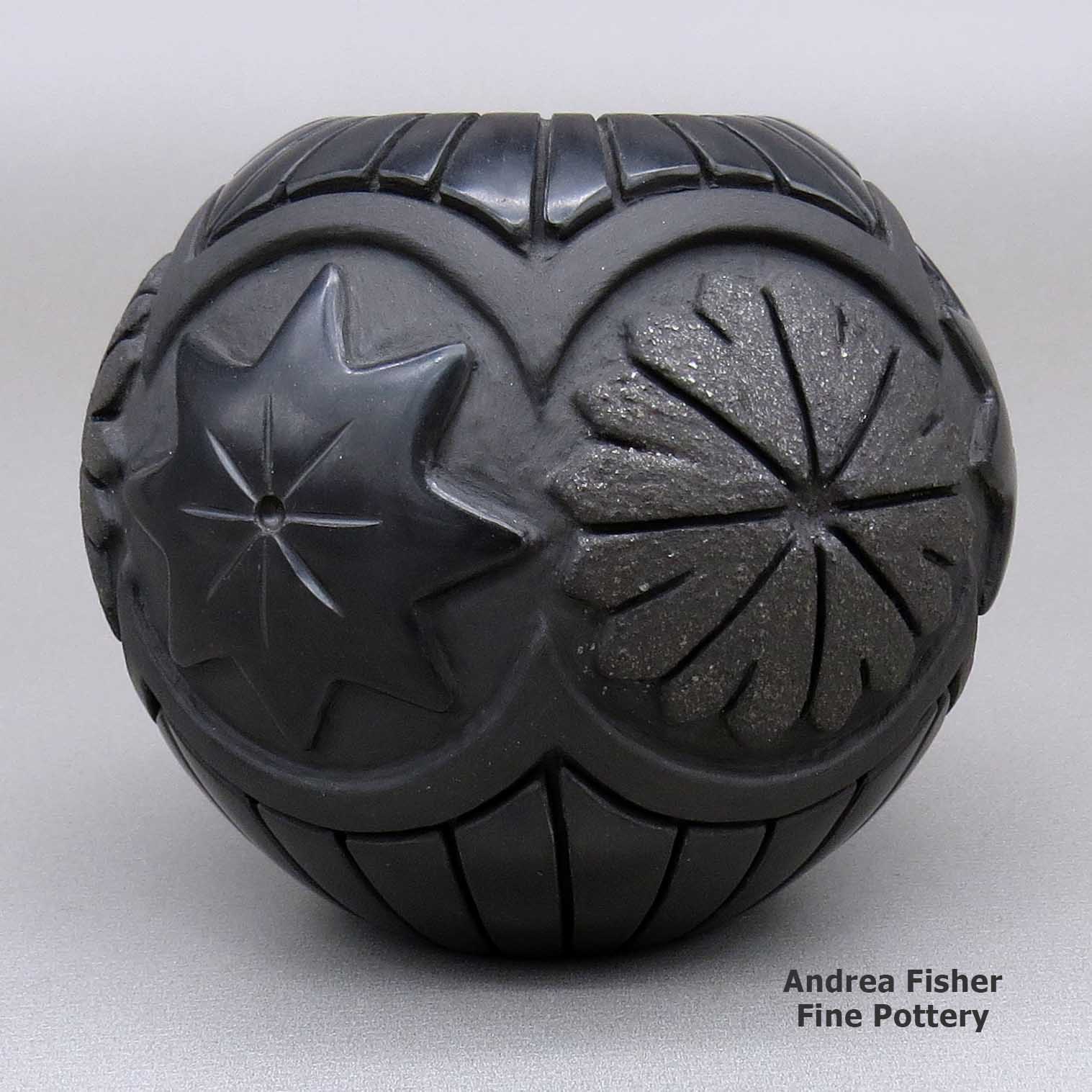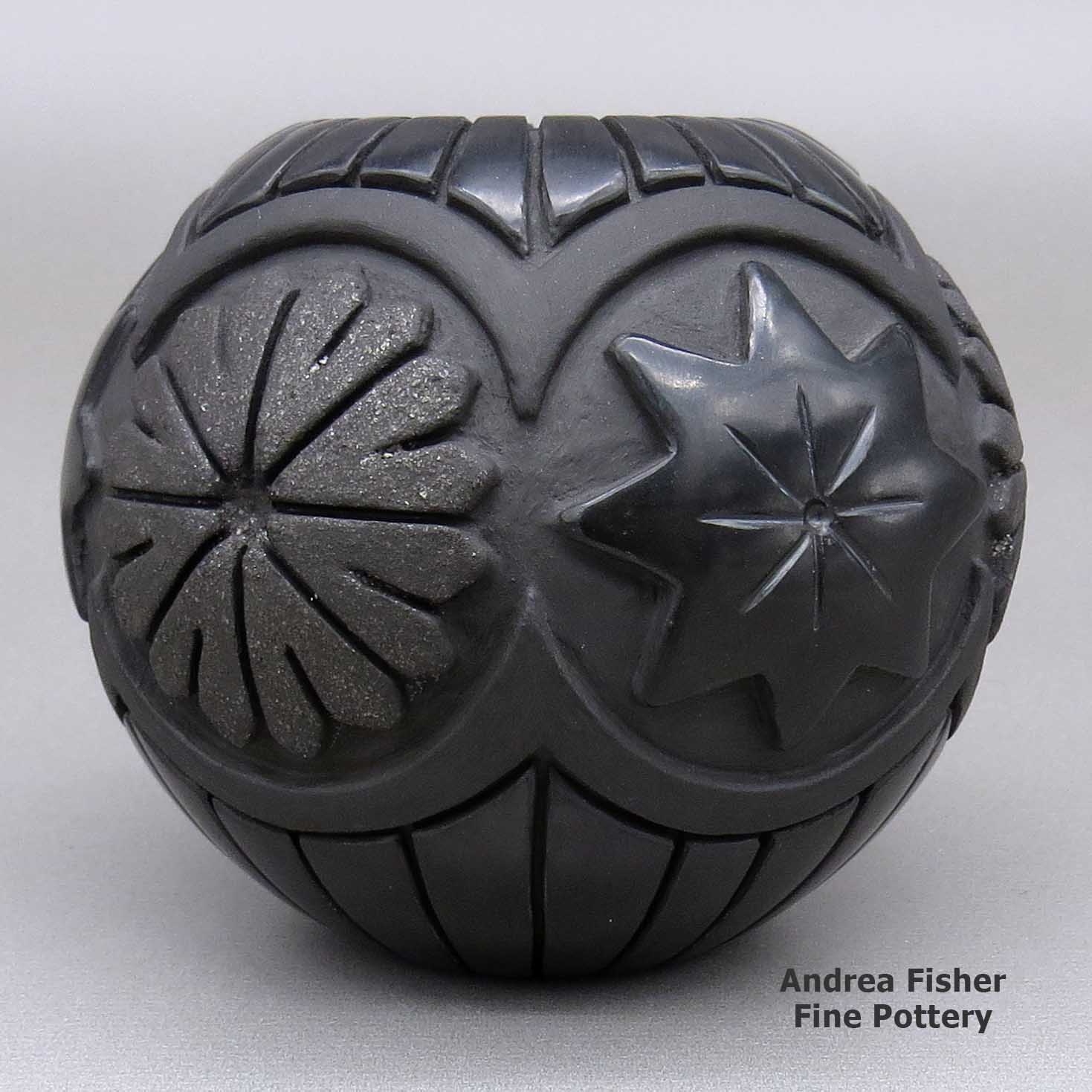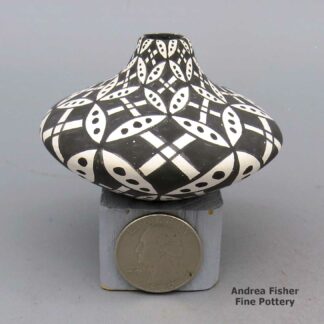| Dimensions | 3.5 × 3.5 × 3.25 in |
|---|---|
| Condition of Piece | Very good, rubbing on bottom |
| Signature | Linda Tafoya-Oyenque Santa Clara San Juan |
Linda Tafoya, spsc3c063, Jar carved with a geometric design
$975.00
A small black jar carved with a geometric design and decorated with micaceous details
In stock
Brand
Tafoya, Linda
Linda made her first pieces of pottery when she was twelve years old. Her father taught her how to form vessels and carve them while her mother taught her sanding and polishing. Her father also taught her his method for firing a perfect black pot and maintaining its high shine. Pieces they worked on together were signed "Lee and Linda." Then she married Dennis Oyenque of Ohkay Owingeh and moved to his home there.
At Ohkay Owingeh she continued to make pottery the Santa Clara way but she also learned Ohkay Owingeh methods and imagery. She was one of the first Santa Clara potters to use micaceous clay on her pieces.
Linda lived at Ohkay Owingeh through the 1980s, signing her pottery: Linda Tafoya Oyenque, Santa Clara/San Juan. When she divorced she returned to Santa Clara.
At Santa Clara she remarried and is now Linda Tafoya Sanchez. She still creates traditional Santa Clara red and black pottery with some Ohkay Owingeh imagery.
Deep carving, light carving, sgraffito, micaceous slips, red and black ware, Linda does it all, and with an exceptional polish, too. She also taught her sons, Antonio and Jeremy, the traditional way to make pottery.
Over the years Linda participated in a number of exhibits, fairs and shows, earning awards regularly from the Heard Museum Guild Indian Fair and Market, Santa Fe Indian Market, Eight Northern Pueblos Arts and Crafts Show and the Gallup Intertribal Ceremonials.
In 2006 Linda was featured on the cover of New Mexico Magazine and was a featured artist in the 2011 Santa Fe Indian Market Magazine.
After all she has accomplished in her career, Linda says one accolade in particular still warms her heart. Early in her career her grandmother, Margaret Tafoya, asked to see some of her pots. She says Margaret looked over her selection and then proclaimed: "You do good pots!" It doesn't get any better than that.
Some Awards earned by Linda
- 1984 - Outstanding Traditional Miniatures, Deer Dancer Annual Pottery Show, Denver, CO
- 1993 - First Place for a miniature melon jar; - First Place for miniature miscellaneous; - Third Place for carved miscellaneous, all at Santa Fe Indian Market
- 1994 - First Place for a black miniature jar; - Second Place for miniature seed pot; - Third Place for a carved jar, all at Santa Fe Indian Market
- 1995 - Best of Division, Heard Museum Guild Indian Fair and Market, Scottsdale, AZ - Geraldine Harris Memorial Award
- 1996 - Ribbons for traditional pottery over 6 inches and traditional miniature under 3 inches, both from Santa Fe Indian Market
- 1997 - Special Award in traditional pottery, Eight Northern Pueblos Arts and Crafts Show
- 1997 Award from Santa Fe Indian Market in the Traditional Bowls and Vases category
- 1998 - Best of Division, piece was presented to the Prince of Spain; - First Place for undecorated black melon bowl and jar; - First Place for carved or incised bowl, all from Santa Fe Indian Market
- Best in Category at the 1998 Gallup Intertribal Ceremonials
- 1999 - First Place for a miniature; - First Place for a traditional pot, both from the Eight Northern Pueblos Arts and Crafts Show
- 2009 - Heard Museum Guild Indian Fair & Market, Classification II - Pottery, Division C - Traditional, Native Clay, Hand Built, Carved (including ribbed and incised): Second Place
- 2009 - Heard Museum Guild Indian Fair & Market, Classification II - Pottery, Division E - Non-Traditional Design or Form with Native Materials: Second Place, shared with Jeremy Oyenque
- 2010 - Heard Museum Guild Indian Fair & Market: Classification II - Pottery: Honorable Mention for Classification II. Awarded for artwork: Ribbed Swirl Melon Pot (22 Ribs)
- 2011 - Heard Museum Guild Indian Fair & Market, Classification II - Pottery, Division C - Traditional, native clay, hand built, carved: Second Place
- 2023 Santa Fe Indian Market, Classification IIA, Category 504 - Pins and Pendants, Honorable Mention
- 2023 Santa Fe Indian Market, Classification IIC, Traditional burnished black or red ware, incised, painted or carved, Best of Division
- 2023 Santa Fe Indian Market, Category 702 - Carved or incised, black or red, over 8 inches, First Place
A Short History of Santa Clara Pueblo

Santa Clara Pueblo straddles the Rio Grande about 25 miles north of Santa Fe. Of all the pueblos, Santa Clara has the largest number of potters.
The ancestral roots of the Santa Clara people have been traced to ancient pueblos in the Mesa Verde region in southwestern Colorado. When the weather in that area began to get dry between about 1100 and 1300 CE, some of the people migrated to the Chama River Valley and constructed Poshuouinge (about 3 miles south of what is now Abiquiu on the edge of the mesa above the Chama River). Eventually reaching two and three stories high with up to 700 rooms on the ground floor, Poshuouinge was inhabited from about 1375 CE to about 1475 CE.
Drought then again forced the people to move. One group of the people went to the area of Puyé (along Santa Clara Canyon, cut into the eastern slopes of the Pajarito Plateau of the Jemez Mountains). Another group went south of there to what we now call Tsankawi. A third group went a bit to the north, following the Rio Chama down to where it met the Rio Grande and founded Ohkay Owingeh on the northwest side of that confluence.
Beginning around 1580, another drought forced the residents of the Puyé area to relocate closer to the Rio Grande. There, near the point where Santa Clara Creek merged into the Rio Grande, they founded what we now know as Santa Clara Pueblo. Ohkay Owingeh was to the north on the other side of the Rio Chama. That same dry spell forced the people down the hill from Tsankawi to the Rio Grande where they founded San Ildefonso Pueblo to the south of Santa Clara, on the other side of Black Mesa.
In 1598 Spanish colonists from nearby Yunqué (the seat of Spanish government near the renamed "San Juan de los Caballeros" Pueblo) brought the first missionaries to Santa Clara. That led to the first mission church being built around 1622. However, the Santa Clarans chafed under the weight of Spanish rule like the other pueblos did and were in the forefront of the Pueblo Revolt of 1680. One pueblo resident, a mixed black and Tewa man named Domingo Naranjo, was one of the rebellion's ringleaders.
When Don Diego de Vargas came back to the area in 1694, he found most of the Santa Clarans were set up on top of nearby Black Mesa (with the people of San Ildefonso, Pojoaque, Tesuque and Nambé). An extended siege didn't subdue them but eventually, the two sides negotiated a treaty and the people returned to their pueblos. However, successive invasions and occupations by northern Europeans took their toll on the pueblos over the next 250 years. The Spanish flu pandemic in 1918 almost wiped them out.
Today, Santa Clara Pueblo is home to as many as 2,600 people and they comprise probably the largest per capita number of artists of any North American tribe (estimates of the number of potters run as high as 1-in-4 residents).
For more info:Pueblos of the Rio Grande, Daniel Gibson, ISBN-13:978-1-887896-26-9, Rio Nuevo Publishers, 2001
Upper photo courtesy of Einar Kvaran, Creative Commons Attribution-Share Alike 3.0 Unported License
About Jars
The jar is a basic utilitarian shape, a container generally for cooking food, storing grain or for carrying and storing water. The jar's outer surface is a canvas where potters have been expressing their religious visions and stories for centuries.
In Sinagua pueblos (in northern Arizona), the people made very large jars and buried them up to their openings in the floors of the hidden-most rooms in their pueblo. They kept those jars filled with water but also kept smaller jars of meat and other perishables inside those jars in the water. It's a form of refrigeration still in use among indigenous people around the world.
Where bowls tend to be low, wide and with large openings, jars tend to be more globular: taller, less wide and with smaller openings.
For a potter looking at decorating her piece, bowls are often decorated inside and out while most jars are decorated only on the outside. Jars have a natural continuity to their design surface where bowls have a natural break at the rim, effectively yielding two design surfaces on which separate or complimentary stories can be told.
Before the mid-1800s, storage jars tended to be quite large. Cooking jars and water jars varied in size depending on how many people they were designed to serve. Then came American traders with enameled metal cookware, ceramic dishes and metal eating utensils...Some pueblos embraced those traders immediately while others took several generations to let them and their innovations in. Either way, opening those doors led to the virtual collapse of utilitarian pottery-making in most pueblos by the early 1900s.
In the 1920s there was a marked shift away from the machinations of individual traders and more toward marketing Native American pottery as an artform. Maria Martinez was becoming known through her exhibitions at various major industrial fairs around the country and Nampeyo of Hano was demonstrating her art for the Fred Harvey Company at the Grand Canyon. The first few years of the Santa Fe Indian Market helped to solidify that movement and propel it forward. It took another couple generations of artists to open other venues for their art across the country and turn Native American art into the phenomenon it has become.
Today's jars are artwork, not at all for utilitarian purposes, and their shapes, sizes and decorations have evolved to reflect that shift.
About Geometric Designs
"Geometric design" is a catch-all term. Yes, we use it to denote some kind of geometric design but that can include everything from symbols, icons and designs from ancient rock art to lace and calico patterns imported by early European pioneers to geometric patterns from digital computer art. In some pueblos, the symbols and patterns denoting mountains, forest, wildlife, birds and other elements sometimes look more like computer art that has little-to-no resemblance to what we have been told they symbolize. Some are built-up layers of patterns, too, each with its own meaning.
"Checkerboard" is a geometric design but a simple black-and-white checkerboard can be interpreted as clouds or stars in the sky, a stormy night, falling rain or snow, corn in the field, kernels of corn on the cob and a host of other things. It all depends on the context it is used in, and it can have several meanings in that context at the same time. Depending on how the colored squares are filled in, various basket weave patterns can easily be made, too.
"Cuadrillos" is a term from Mata Ortiz. It denotes a checkerboard-like design using tiny squares filled in with paints to construct larger patterns.
"Kiva step" is a stepped geometric design pattern denoting a path into the spiritual dimension of the kiva. "Spiral mesa" is a similar pattern, although easily interpreted with other meanings, too. The Dineh have a similar "cloud terrace" pattern.
That said, "geometric designs" proliferated on Puebloan pottery after the Spanish, Mexican and American settlers arrived with their European-made (or influenced) fabrics and ceramics. The newcomers' dinner dishes and printed fabrics contributed much material to the pueblo potters design palette, so much and for so long that many of those imported designs and patterns are considered "traditional" now.
Margaret Tafoya Family Tree - Santa Clara Pueblo
Disclaimer: This "family tree" is a best effort on our part to determine who the potters are in this family and arrange them in a generational order. The general information available is questionable so we have tried to show each of these diagrams to living members of each family to get their input and approval, too. This diagram is subject to change should we get better info.
- Margaret Tafoya (1904-2001) & Alcario Tafoya (d. 1995)
- Mary Ester Archuleta (1942-2010)
- Barry Archuleta
- Bryon Archuleta
- Sheila Archuleta
- Jennie Trammel (1929-2010)
- Karen Trammel Beloris
- Virginia Ebelacker (1925-2001)
- James Ebelacker (1959-) & Cynthia Ebelacker
- Jamelyn Ebelacker
- Sarena Ebelacker
- Richard Ebelacker (1946-2010) & Yvonne Ortiz
- Jason Ebelacker
- Jerome Ebelacker & Dyan Esquibel
- Andrew Ebelacker
- Nicholas Ebelacker
- James Ebelacker (1959-) & Cynthia Ebelacker
- Lee Tafoya (1926-1996) & Betty Tafoya (Anglo) (1933-1988)
- Linda Tafoya (Oyenque)(Sanchez)(1962- )
- Antonio Jose Oyenque
- Jeremy Rio Oyenque
- Maria Theresa Oyenque
- Melvin Ray Tafoya (1957- )
- Phyllis Bustos Tafoya
- Linda Tafoya (Oyenque)(Sanchez)(1962- )
- Mela Youngblood (1931-1990) & Walt Youngblood
- Nancy Youngblood (1955- )
- Nathan Youngblood (1954- )
- Toni Roller (1935-) & Ted Roller
- Brandon Roller
- Cliff Roller (1961- )
- Deborah Morning Star Roller
- Jeff Roller (1963- )
- Jordan Roller (1987- )
- Ryan Roller
- Susan Roller Whittington (1955- )
- Charles Lewis (1972- )
- Tim Roller (1959- )
- William Roller
- LuAnn Tafoya (1938- ) & Sostence Tapia
- Michele Tapia Browning (1960- )
- Ashley Browning
- Mindy Browning
- Daryl Duane Whitegeese (1964- ) & Rosemary Hardy
- Samantha Whitegeese
- Tina Whitegeese
- Michele Tapia Browning (1960- )
- Shirley Cactus Blossom Tafoya (1947-)









